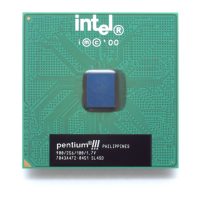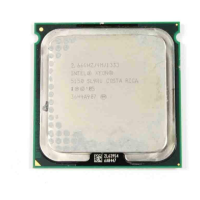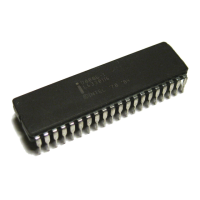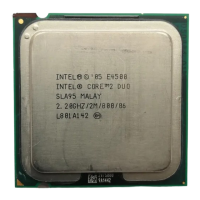Datasheet 21
Electrical Specifications
2.6 FSB Signal Groups
The FSB signals have been combined into groups by buffer type. GTL+ input signals have
differential input buffers, which use GTLREF as a reference level. In this document, the term
"GTL+ Input" refers to the GTL+ input group as well as the GTL+ I/O group when receiving.
Similarly, "GTL+ Output" refers to the GTL+ output group as well as the GTL+ I/O group when
driving.
With the implementation of a source synchronous data bus comes the need to specify two sets of
timing parameters. One set is for common clock signals which are dependent upon the rising edge
of BCLK0 (ADS#, HIT#, HITM#, etc.) and the second set is for the source synchronous signals
which are relative to their respective strobe lines (data and address) as well as the rising edge of
BCLK0. Asychronous signals are still present (A20M#, IGNNE#, etc.) and can become active at
any time during the clock cycle. Table 2-3 identifies which signals are common clock, source
synchronous, and asynchronous.
Table 2-3. FSB Signal Groups
Signal Group Type Signals
1
GTL+ Common Clock Input
Synchronous to
BCLK[1:0]
BPRI#, DEFER#, RS[2:0]#, RSP#, TRDY#
GTL+ Common Clock I/O
Synchronous to
BCLK[1:0]
AP[1:0]#, ADS#, BINIT#, BNR#, BPM[5:0]#, BR0#, DBSY#,
DP[3:0]#, DRDY#, HIT#, HITM#, LOCK#, MCERR#
GTL+ Source Synchronous I/O
Synchronous to assoc.
strobe
GTL+ Strobes
Synchronous to
BCLK[1:0]
ADSTB[1:0]#, DSTBP[3:0]#, DSTBN[3:0]#
GTL+ Asynchronous Input
A20M#, IGNNE#, INIT#, LINT0/INTR, LINT1/NMI, SMI#,
STPCLK#, RESET#
GTL+ Asynchronous Output FERR#/PBE#, IERR#, THERMTRIP#
GTL+ Asynchronous Input/Output PROCHOT#
TAP Input Synchronous to TCK TCK, TDI, TMS, TRST#
TAP Output Synchronous to TCK TDO
FSB Clock Clock BCLK[1:0], ITP_CLK[1:0]
2
Power/Other
VCC, VTT, VCCA, VCCIOPLL, VID[5:0], VSS, VSSA, GTLREF,
COMP[1:0], RESERVED, TESTHI[13:0], THERMDA,
THERMDC, VCC_SENSE, VSS_SENSE, BSEL[2:0],
SKTOCC#, DBR#
2
, VTTPWRGD, BOOTSELECT, PWRGOOD,
VTT_OUT_LEFT, VTT_OUT_RIGHT, VTT_SEL, LL_ID[1:0],
FCx, VSS_MB_REGULATION, VCC_MB_REGULATION,
MSID[1:0]
Signals Associated Strobe
REQ[4:0]#, A[16:3]#
3
ADSTB0#
A[35:17]#
3
ADSTB1#
D[15:0]#, DBI0# DSTBP0#, DSTBN0#
D[31:16]#, DBI1# DSTBP1#, DSTBN1#
D[47:32]#, DBI2# DSTBP2#, DSTBN2#
D[63:48]#, DBI3# DSTBP3#, DSTBN3#

